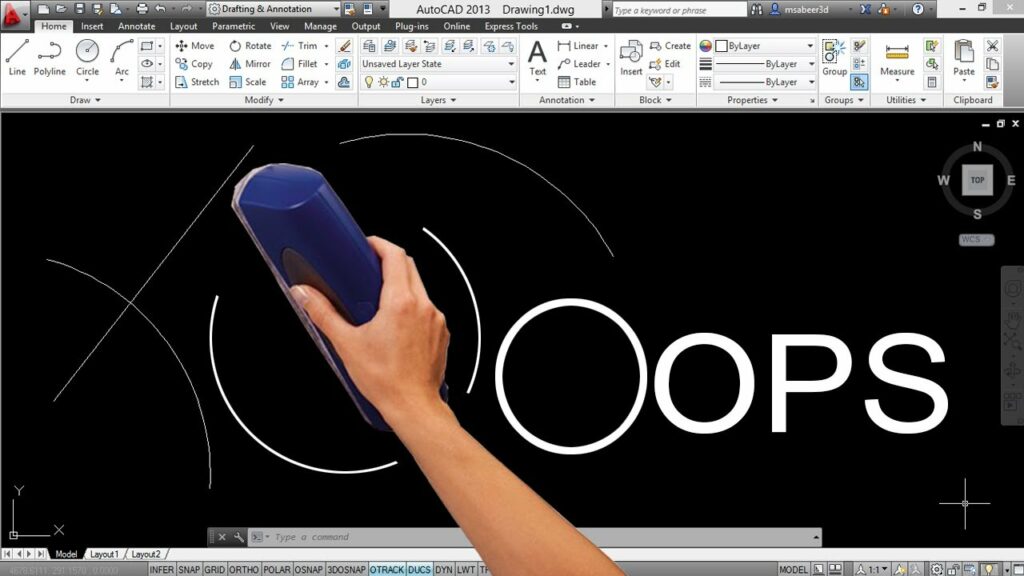A Journey of Undoing: A Comprehensive Exploration of the OOPS Command in AutoCAD

Introduction:
AutoCAD, a cornerstone in the realm of computer-aided design (CAD), stands as a dynamic canvas where architects, engineers, and designers bring their ideas to life. Amidst the myriad features that define AutoCAD’s capabilities, the “OOPS” command emerges as a silent hero, offering users the power to undo unintended actions and regain control over their design process. This extensive article delves into the intricacies of the OOPS command in AutoCAD, exploring its functionalities, applications, and the transformative impact it has on achieving precision and creative freedom within the design environment.
Understanding the OOPS Command in AutoCAD:
The OOPS command in AutoCAD is a powerful tool designed to undo the last set of operations, providing users with a quick and efficient way to rectify mistakes or unintended changes. This command essentially acts as a safety net, allowing designers to revert to a previous state of the drawing and recover from errors without the need for manual corrections. The simplicity and effectiveness of the OOPS command make it an integral part of the AutoCAD experience, contributing to a fluid and flexible design workflow.
Key Features and Functionalities:
- Undoing Recent Operations: The primary function of the OOPS command is to undo the last set of operations performed in the drawing. This includes various actions such as drawing, modifying objects, or executing commands. OOPS acts as a quick and immediate way to backtrack and correct unintended changes.
- Multiple Undo Levels: AutoCAD maintains a series of undo levels, allowing users to step back through multiple stages of the drawing history. While the OOPS command specifically targets the most recent set of operations, the overall undo functionality in AutoCAD provides a broader spectrum of control over the drawing’s evolution.
- Recovery from Mistakes: Mistakes are an inevitable part of the design process. The OOPS command serves as a safety mechanism, enabling designers to recover swiftly from errors without the need for manual correction. This feature is especially valuable when experimenting with design ideas or exploring different iterations.
- Quick Accessibility: OOPS is easily accessible through the command line, making it a convenient option for immediate undoing of the last set of operations. Users can simply type “OOPS” and press Enter, triggering the undo action and restoring the drawing to its previous state.
Applications of the OOPS Command:
- Precision Editing: In the meticulous world of CAD design, precision is paramount. The OOPS command allows designers to maintain a high level of precision by swiftly undoing unintended modifications, ensuring that the final drawing aligns with the intended design intent.
- Iterative Design Exploration: Design is an iterative process that often involves experimentation and exploration of various concepts. The OOPS command provides the flexibility to try different approaches and quickly revert to previous states, facilitating a creative and dynamic design exploration.
- Error Correction in Collaborative Projects: In collaborative design projects involving multiple team members, errors can occur. The OOPS command becomes a valuable asset in correcting mistakes made by different contributors, fostering a collaborative environment where design decisions can be refined and adjusted seamlessly.
- Efficiency in Drawing Cleanup: When cleaning up a drawing or making final adjustments, the OOPS command streamlines the process by providing a quick way to undo recent changes. This efficiency is crucial in meeting deadlines and ensuring the drawing is polished and error-free.
Optimizing Workflow with the OOPS Command:
- Utilizing Keyboard Shortcuts: To enhance efficiency, users can assign keyboard shortcuts to the OOPS command. This allows for quick execution without the need to type the full command, streamlining the workflow and providing a more fluid user experience.
- Understanding Additional Undo Options: AutoCAD offers multiple ways to undo operations, including the traditional “UNDO” command and the “U” keyboard shortcut. Familiarizing oneself with these options ensures that designers have a comprehensive understanding of the undo capabilities available.
- Regularly Saving Incremental Versions: While the OOPS command is a powerful tool for undoing recent operations, it is advisable to regularly save incremental versions of the drawing. This precautionary measure ensures that designers have a backup to revert to in case of more extensive changes or unforeseen issues.
- Experimenting in Design Workspaces: Designers are encouraged to leverage the OOPS command when working in different design workspaces or experimenting with advanced features. This flexibility allows for fearless exploration, knowing that unintended changes can be swiftly undone.
Conclusion:
In conclusion, the OOPS command in AutoCAD stands as a fundamental tool for designers seeking precision, flexibility, and creative freedom in their CAD endeavors. Its ability to undo the last set of operations, coupled with the broader undo functionality, empowers users to navigate the intricacies of the design process with confidence. As AutoCAD continues to evolve, the emphasis on features like the OOPS command reflects the software’s commitment to providing users with tools that transcend traditional drafting boundaries. Embrace the power of the OOPS command, and witness the transformation of your AutoCAD experience into a journey of precision, efficiency, and creative exploration within the vast landscape of CAD design.




